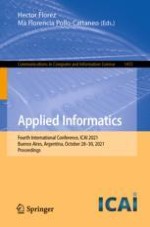2021 | Book
Applied Informatics
Fourth International Conference, ICAI 2021, Buenos Aires, Argentina, October 28–30, 2021, Proceedings
Editors: Hector Florez, Ma Florencia Pollo-Cattaneo
Publisher: Springer International Publishing
Book Series : Communications in Computer and Information Science
